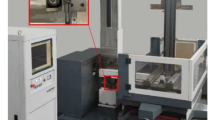Abstract
In order to further improve the process index of high-thickness cutting of micro high-speed wire electrical discharge machining (micro-WEDM), a self-limiting wire guide (SWG) device was designed, which realized high-performance cutting of workpieces with a thickness of 20 mm by using Φ80 μm wire electrode. The modal simulation results show that the SWG device can increase the natural frequency of the wire electrode and can buffer and isolate the vibration of the wire electrode. Under the same processing conditions, compared with unlimited device processing, the SWG device processing is more stable. The average surface roughness Ra is 2.4 μm, which is 35% lower than that of without limiting device, and there is no obvious reversal stripe on the surface. The uniformity of kerf width and the consistency of cutting size are better. The corner error is reduced by 63.5% when machining a 90° convex corner, and the material removal rate is relatively increased by 7%.











Similar content being viewed by others
Data availability
The data and materials set supporting the results are included within the article.
References
Yukui W, Xiang C, Weimin G, Zhenlong W, Cheng G (2016) Complex rotary structures machined by micro-WEDM. Procedia Cirp 42:743–747
Chen X, Wang Z, Xu J, Wang Y, Li J, Liu H (2018) Sustainable production of micro gears combining micro reciprocated wire electrical discharge machining and precision forging. J Clean Prod 188:1–11
Xing Z (2006) Practical research on microwire EDM machining technology based on AGIE CHALLENGE ECUT 2F machine tool. Nanjing China: Nanjing University of Aeronautics and Astronautics (In Chinese)
Tahmasebipour M, Tahmasebipour Y, Vafaie A (2019) Microwire electrical discharge machining of MEMS structures with optimized dimensional deriation. Int J of Adv Desi Manuf Technol 12(2):103–109
Takuya M, Yukihiro Y, Kojiro M, Akimaro K (2018) Effect of wall surface wettability on pressure drop of gas-liquid two-phase flow in horizontal rectangular micro-channel. Proceed Conf Kyush Branch 71:A32
Tang WL, Liu H, Zhu LY, Shi JP, Li ZG, Nan X, Yang JQ (2019) Fabrication of different microchannels by adjusting the extrusion parameters for sacrificial molds. Micromachines 10(8):544–555
Jasim A (2018) Parametric optimization of process parameters on surface integrity in WEDM of Al-2024 metal matrix composite using Taguchi approach. J Eng Appl Sci 13(18):7590–7598
Ali MY, Khamarruzaman SNZ, Banu A (2017) Investigation of kerf in micro wire electro discharge machining. IOP Conf Series Mater Sci Eng 184:012033
Kumar R, Singh I (2018) Productivity improvement of micro EDM process by improvised tool. Preci Eng 51:529–535
Habib S, Okada A (2016) Study on the movement of wire electrode during fine wire electrical discharge machining process. J Mater Process Technol 227:147–152
Arunachalam C, Aulia M, Bozkurt B, Eubank PT (2001) Wire vibration, bowing, and breakage in wire electrical discharge machining. J Appl Phy 89(8):4255–4262
Das S, Joshi SN (2020) Estimation of wire strength based on residual stresses induced during wire electric discharge machining. J Manuf Process 53:406–419
Han F, Cheng G, Feng Z, Isago S (2008) Thermo-mechanical analysis and optimal tension control of micro wire electrode. Int J Adv Manuf Technol 48(7–8):922–931
Yan MT, Huang PH (2004) Accuracy improvement of wire-EDM by real-time wire tension control. Int J Mach Tools Manuf 44(7–8):807–814
Di SC, Huang RN, Chi GX, Zhao WS (2007) Fabrication of micro parts with micro-WEDM. Ke Engin Mater 339:297–301
Lu DX, Chen CW (2001) Floating electrode wire stopper. Elect Mach Moul (In Chinese) 6:54
Chao JL, Yong FG, Ji CB, Ze SL, Chuan Ch (2012) Study on modeling and simulation of wire vibration in WEDM. Adv Mater Re 1671:472–475
Pan H, Liu Z, Li C, Zhang Y, Qiu M (2017) Enhanced debris expelling in high-speed wire electrical discharge machining. Int J Adv Manuf Technol 93(5–8):1–8
Wei W, Zhidong L, Wentai S, Yueqin Z, Zongjun T (2016) Surface burning of high-speed reciprocating wire electrical discharge machining under large cutting energy. Int J Adv Manuf Technol 87:9–12
Wentai S, Zhidong L, Mingbo Q, Zongjun T, Hao Y (2016) Simulation and experimental study of wire tension in high-speed wire electrical discharge machining. J Mater Process Technol 229:722–728
Wang Y, Yao S-W, Ding Z-J, Chen-zhen Wu, Xiong W (2021) Machining characteristics of USV-MF complex assisted WEDM-LS based on multi-physical coupling. Int J Precis Eng Manuf GN Technol 8:387–404
Funding
This work was supported by the Science and Technology Plan Project of Changzhou (Basic Research for Application) (CJ20220075), the Natural Science Foundation of the Jiangsu Higher Education Institutions of China (22KJB460019), and the National Natural Science Foundation of China (Grant No. 51975264). We also extend our sincere thanks to all who contributed to the preparation of this manuscript.
Author information
Authors and Affiliations
Contributions
All authors have been personally and actively involved in substantive work leading to the report.
Corresponding authors
Ethics declarations
Ethical approval
Not applicable.
Consent to participate
Not applicable.
Consent for publication
Not applicable.
Competing interests
The authors declare no competing of interests.
Additional information
Publisher's note
Springer Nature remains neutral with regard to jurisdictional claims in published maps and institutional affiliations.
Rights and permissions
Springer Nature or its licensor (e.g. a society or other partner) holds exclusive rights to this article under a publishing agreement with the author(s) or other rightsholder(s); author self-archiving of the accepted manuscript version of this article is solely governed by the terms of such publishing agreement and applicable law.
About this article
Cite this article
Zhang, S., Chen, G., Kong, L. et al. Research on the influence of limit wire guide on high thickness cutting of micro high-speed WEDM. Int J Adv Manuf Technol 125, 4065–4072 (2023). https://doi.org/10.1007/s00170-023-11032-w
Received:
Accepted:
Published:
Issue Date:
DOI: https://doi.org/10.1007/s00170-023-11032-w



